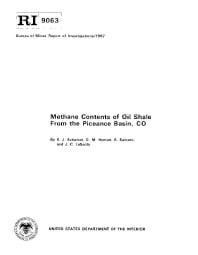Mining Publication: Methane Contents of Oil Shale From the Piceance Basin, CO
Original creation date: January 1987
Authors: SJ Schatzel, DM Hyman, A Sainato, JC LaScola
NIOSHTIC2 Number: 10005639
U.S. Department of the Interior, Bureau of Mines. Report of Investigations 9063, NTIS No. PB87-216453, 1987; :1-32
The Bureau of Mines determined the gas contents of 135 oil shale samples obtained from approximately 630 ft of core drilling. Drilling was done within a projected mining zone of the Cathedral Bluffs Mine, located in the Piceance basin of western Colorado. Methane contents were determined by the modified direct method, which can measure the volumes of several gases released from or reacted with mine rock without destructive sample treatment. Over the duration of the test, nitrogen was largely unreactive, co2 increased slightly, oxygen decreased markedly, and methane increased more than the total increase of all contained gases. The gas volumes were normalized per unit sample mass and are given in cubic centimeters per gram. Common time indices for test duration of 3, 40, and 125 days were used to compare methane desorption among samples. The means of the sample populations for these indices were 0.0316, 0.114, and 0.195 Cm3/g, respectively. These quantities are lower than those reported in a Bureau emissions study at the Horse Draw Mine in the Piceance Basin. Oil shale samples that were gas enriched beyond the mean methane contents frequently contained bitumens and pyrite.

NIOSHTIC2 Number: 10005639
U.S. Department of the Interior, Bureau of Mines. Report of Investigations 9063, NTIS No. PB87-216453, 1987; :1-32
- Investigation of Methane Emissions From an Advancing Face in the Belle Isle Domal Salt Mine, Louisiana
- Methane Absorption in Oil Shale and Its Potential Mine Hazard
- Methane Content of Gulf Coast Domal Rock Salt
- Methane Control by Isolation of a Major Coal Panel - Pittsburgh Coalbed
- Methane Diffusion Parameters for Sized Coal Particles: A Measuring Apparatus and Some Preliminary Results
- Methane Emission from U.S. Coal Mines, A Survey
- Methane Emission Rate Studies in a Northern West Virginia Mine
- Modeling and Prediction of Ventilation Methane Emissions of U.S. Longwall Mines Using Supervised Artificial Neural Networks
- Reservoir Rock Properties of Coal Measure Strata of the Lower Monongahela Group, Greene County (Southwestern Pennsylvania), from Methane Control and Production Perspectives
- Technology News 465 - Method for Predicting Methane Emissions on Extended Longwall Faces